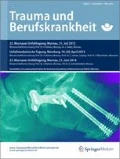Hör- und Gleichgewichtsstörungen sind nach nicht-knöchernen Verletzungen des Kopfs sowie der Halswirbelsäule (HWS) keine Seltenheit. Insbesondere Anprallverletzungen mit einem direkten Anschlagen des Kopfs bzw. dem Anschlagen eines Gegenstands am Kopf können durch den Unfallmechanismus der Labyrintherschütterung (Commotio labyrinthi) eine Innenohrhörstörung, z. B. Tinnitus, mit oder ohne Schwindelbeschwerden, hervorrufen. In der vorliegenden Arbeit wird über eine Patientenpopulation von 63 Patienten berichtet, die in den letzten Jahren (1998–2000) wegen isolierter Beschwerden in diesem Bereich in der HNO-Klinik diagnostiziert und therapiert wurden. Es fanden sich verschiedene Unfallmechanismen (z. B. Treppensturz, HWS-Weichteildistorsion mit Kontakttrauma, Stauchungsverletzung der HWS durch Abwurf vom Pferd usw.) sowie eine unterschiedliche Symptomausprägung. Als Leitsymptome wurden überwiegend Schwindel (84%), Tinnitus (63%) sowie eine Hörstörung (23%) gesehen. In der Regel wurde nach einer Funktionsdiagnostik des Hör- und Gleichgewichtsorgans mit einer konservativ-medikamentösen Therapie begonnen, wobei sich die Beschwerden nicht immer vollständig zurückbildeten. Der Tinnitus (18%) sowie die Schwindelbeschwerden (12%) bedurften ¶einer Zusatztherapie im Intervall. Eine operative Therapie wegen persistierender Schwindelbeschwerden wurde 2-mal notwendig.
Audiovestibular disorders frequently follow injuries sustained to the head or the cervical spine without any fracture. The main symptoms include sensorineural hearing loss (SNHL) and tinnitus, with or without vertigo. The present paper reports on 63 patients diagnosed and treated over the last 2 years in this department (1997–1999). Several trauma mechanisms were encountered (e.g., falling downstairs, soft tissue distorsion of the neck with or without contact trauma, blunt trauma of the cervical column caused by falling off a horse with the head down) and various combinations of symptoms. The main symptoms were vertigo (84%), tinnitus (63%) and SNHL (23%). After audiovestibular diagnostic tests, conservative treatment was started. The therapy was not completely effective in all cases: 18% of the patients with tinnitus and 12% of those with vertigo needed further treatment, and 2 of the patients in the latter subpopulation required surgery.
Author information
Authors and Affiliations
Rights and permissions
About this article
Cite this article
Ernst, A., Seidl, R., Nölle, C. et al. Hör- und Gleichgewichtsstörungen nach Kopfanpralltraumen. Trauma Berufskrankh 3, 27–31 (2001). https://doi.org/10.1007/s100390000343
Issue Date:
DOI: https://doi.org/10.1007/s100390000343

